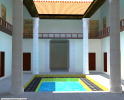Domus with Peristylium
This page deals with a house with peristylium in ancient Rome. There are a room layout, names of each part, and reconstruction images.
This type of house, "Domus with Peristylium", has the addition of a peristyle garden behind the Etruscan style house, "Domus with Atrium". It was built from the second century B.C. Wealthy and middle class family dwelt in this kind of house.
This house has an atrium, and a peristylium. The "peristylium" is a open colonnaded garden in the house ("domus"). The roofs over the atrium and peristylium are open to the sky in order to admit light and fresh air. This model is two stories high. The sunshine is admitted from the atrium and peristylium, and there are few windows opening outward. This structure is helpful in keeping away from noise of the city and danger like "Domus with Atrium". The rooms have beautiful paintings on the wall, and mosaic floors.
| Number | Name | Latin | Commentary |
|---|---|---|---|
| (1) | foyer entrance |
fauces | The fauces literally means "throat". It is a narrow foyer, which leads to the atrium. The entrance hall is called "vestibulum". |
| (2) | rooms bedrooms |
cubicula (sg. cubiculum) |
The series of rooms opening onto the atrium are called cubicula, which is usually used as families' bedrooms. Both side of the fauces are sometimes shops for rent ("tabernae"). In such case, the rooms open outward. |
| (3) | wings | alae | These two rooms both side of atrium are multipurpose. Sometimes they are used to store hallowed masks or the bust of family ancestors. The singular is "ala" which means wing. |
| (4) | atrium | atrium | The atrium is a open central court, or central reception area. The roof over the atrium is open in order to admit light and to impound rainwater. The rainwater pours from the roof opening ("compluvium" in Latin) into a basin ("impluvium" in Latin). |
| (5) | dining room | triclinium | This room is a formal dining room, which called "triclinium". The name "triclinium" is derived from Greek words, "tri-" (three) and "kline" (couch). There are three couches (sg: "lectus", pl: "lecti" in Latin) on three sides of a low square table. The master of the house and the guests hold a feast lying on these couches. This was a formal style in ancient Rome. |
| (6) | office, study | tablinum | The room open to the atrium and opposite to the entrance is called "tablinum". The name tablinum is derived from "tabula" (writing tablet or document), and this room is used as an office where the master of the house does office work, and greets his clients ("cliens" in Latin) . |
| (7) | passage hallway |
andron | This space is a passage leading from atrium to peristylium. |
| (8) | storeroom | This room used as a storeroom next to the alae. For example, this space is sometimes used as library, "librarium" in Latin. | |
| (9) | rooms bedrooms |
cubicula (sg. cubiculum) |
The series of rooms opening onto the peristylium are used as larger bedrooms than cubicula around atrium. In the case of wealthy family, there are sometimes bathrooms ("latrina"). |
| (10) | back door | posticum | The peristylium has a back door. Slaves, retailers etc come in and out. |
| (11) | peristyle garden | peristylium | The peristylium is a open colonnaded garden within the building. It keeps flowers, trees, fountains, benches, fishpond ("piscina"), etc. There are also herbs for cooking. Romans can relax and enjoy a garden. The "Lararium", which is a shrine for the household gods "Lares", is located in the peristylium, or in the atrium. |
| (12) | kitchen | culina | This room is used for food preparation or cooking. The toilet ("latrina") is usually located in the kitchen, and wastes are discharged into sewers. |
| (13) | exedra | exedra | The "Exedra" is a room opening into the peristylium, and used for feasts or meeting. The wall paintings are usually very elaborated and its theme is connected to the garden. |
| (14) | summer dining room | triclinium | This room, "triclinium", is also a dining room like the triclinium around the atrium, but this is wide open into the peristylium. So, this room is used as the place to eat in the shade getting away from the sun during the hot summer. |
Click the image to enlarge. Copyrighted by Shiro Kawashima.
Click the image to enlarge. Copyrighted by Shiro Kawashima.
Click the image to enlarge. Copyrighted by Shiro Kawashima.

Click the image to enlarge. Copyrighted by Shiro Kawashima.